
Für eine deutsche Übersetzung dieser Seite einfach die Brandenburger Flagge anklicken
 |
Click the Brandenburg Flag for a German translation Für eine deutsche Übersetzung dieser Seite einfach die Brandenburger Flagge anklicken |


|
|
SaturnA collection of pictures of the planet Saturn
|
|



|
The gas giant Saturn is the second largest planet in our solar system and best known for its
ring system.
Saturn has been known since ancient times. It was first observed by telescope in 1610 by Galileo Galilei. In 1659, Christiaan Huygens, using a better telescope than Galileo, discovered Jupiter's rings. The first closeup pictures were delivered during the flyby of Pioneer 11 in 1973. Since then, two other probes flew by Jupiter and the Cassini probe orbited the planet for 13 years.
The Hubble space telescope too delivered some very detailed images. The picture to the left was taken by Hubble on June 20 2019.
|

|
Here is a set of early pictures of Saturn. Like our other space galleries, the pictures have not been selected because of their
scientific significance but because of their esthetic value and sometimes because of their historical importance.
|

|
Like Jupiter, Saturn too has been systematically observed by
Babylonian astronomers as early as 3500 BC. The first one to look at Saturn through a telescope, was Galileo in 1610. His telescope was not strong enough the see Saturn's ring, thus he interpreted the planet's oval shape as a planet closely accompanied by two moons. A first idea of a ring system was shown in Galieo's 1616 drawing. In 1655, Huygens first suggested a "thin, flat ring, nowhere touching, and inclined to the ecliptic." In 1656, he discovered Saturn's largest moon, Titan. In 1969, using stronger telescopes, Huygens confirmed Saturn's ring system. In the same year, he published his Systema Saturnium, which contained a history of early observations. In 1666, Robert Hooke observed the shadows the planet and its rings cast at each other and in 1675, Domenico Cassini discovered a first gap in the ring system, now known as the Cassini Division. |
  Galileo's drawing of Saturn, 1610 Source: NASA / Dr. Paul Mahaffy
|
  Galileo's drawing of Saturn, 1616 Source: NASA / Dr. Paul Mahaffy
|

|
The first closeup pictures of Saturn were brought to us by NASA's Pioneer 11 spacecraft.
The probe was launched on April 6, 1973. In April 1974 it passed the Asteroid Belt and on December 3, 1974, it passed Jupiter in a gravity assist
maneuver. On September 1, 1979, Pioneer 11 passed Saturn at a distance of 12,795 miles (20,591 km). The picture below right was taken on approach to the planet on that day.
|
 |

|
|
Artist's concept of Pioneer 11 passing Saturn Source: NASA |
Picture taken by Pioneer 11 on approach to Saturn on September 1, 1979. Source: NASA / Planetary Society |

  Saturn and its rings September 1, 1979 Source: NASA / Wikipedia |
  First picture of Titan September 2, 1979 Source: NASA / Planetary Society |
  Voyager 2 high-resolution view of Saturn's rings; August 23, 1981 Source: NASA / JPL |

Pioneer 11 delivered some closeup pictures of the ring system (above, left) and a first, fussy image of Titan (above, center).
 The Pioneer 10 and 11 probes were the first human-made objects to explore two of the outer planets. They paved the way for an even more ambitious project, the planetary cruise of the Voyager probes.  On November 12, 1980 and August 26, 1981, respectively Voyager 1 and Voyager 2 passed Saturn and delivered a number of impressive images of the ringed planet and its moons (above, right and pictures below). |

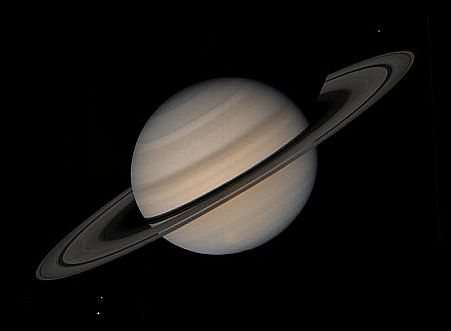 |

|
|
Saturn and its moons Tethys, Enceladus (bottom left) and Mimas (upper right) during Voyager 1's approach on October 30, 1980 from a distance of 18 million kilometers (11 million miles). Source: NASA / JPL |
Voyager 1, looking back at Saturn four days after the passage. November 16, 1980 from a distance of 5.3 million kilometers (3.3 million miles) Source: NASA / Planetary Society |

 |
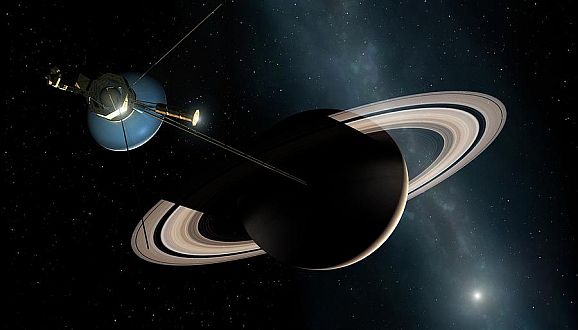
|
|
Voyager 2's departure shot, August 29, 1981 Source: NASA / Planetary Society |
Artist's concept of Voyager 2 passing Saturn Source: fineartamerica.com |


|
The Voyager probes also took close pictures of Saturn's seven larger moons. The four 1980 imaages were taken by Voyager 1, the three 1981 photos came
from Voyager 2. We have devoted extra pages to these moons following the Saturn pages and starting with Titan. |
  Titan November 9, 1980 Source: NASA |
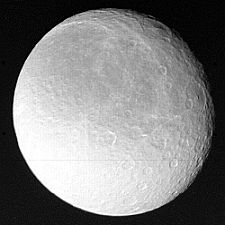  Rhea November 12, 1980 Source: NASA |
  Dione November 12, 1980 Source: NASA |

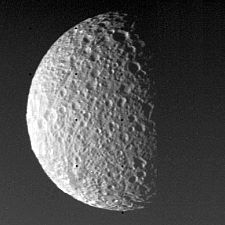  Mimas November 13, 1980 Source: NASA |
  Iapetus August 22, 1981 Source: NASA |
  Enceladus August 25, 1981 Source: NASA / Planetary Society |
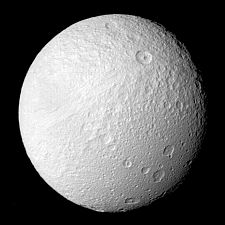  Tethys August 26, 1981 Source: NASA / Planetary Society |


|
On July 1, 2004, the Cassini–Huygens probe was inserted into Saturn's
orbit. For 13 years, until September 15, 2017, Cassini orbited Saturn and delivered thousands of pictures of the planet, its rings and its moons. |

|


|
|
Click here to return to Jupiter's smaller moons | Click here to move on to Saturn's orbit |
|

|
Back to Solar System Page |
Back to Space Page |
Back to English Main Page |
 Back to Start Page |